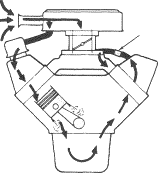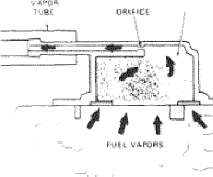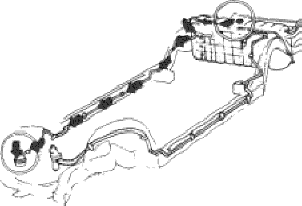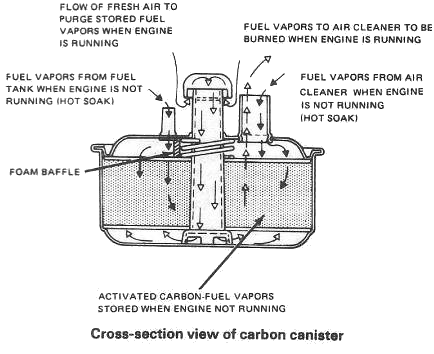Maverick and Comet Repair
Emission Controls
EMISSION CONTROLS
There are 3 basic sources of automotive pollution in the modern
internal combustion engine. They are the crankcase with its
accompanying blow-by vapors, the fuel system with its
evaporation of unburned gasoline, and the combustion chambers
with their resulting exhaust emissions. Pollution arising from
the incomplete combustion of fuel generally falls into 3
categories;
hydrocarbons (HC), carbon monoxide (CO), and
oxides of nitrogen (NO*).
Positive Crankcase Ventilation
System
All Mavericks and Comets are equipped with a
positive crankcase ventilation (PCV) system to control crankcase
blow-by vapors. The system consists of a PCV valve and oil
separator mounted on top of the valve cover, a non-ventilated
oil filter cap, and a pair of hoses supplying filtered intake
air to the valve cover and delivering the crankcase vapors from
the valve cover to the intake manifold (six-cylinder) or
carburetor (V8). The system functions as follows: When the
engine is running, a small portion of the gases which are formed
in the combustion chamber leak by the piston rings and enter the
crankcase. Since these gases are under pressure, they tend to
escape from the crankcase and enter the atmosphere. If these
gases are allowed to remain in the crankcase for any period of
time, they contaminate the engine oil and cause sludge to build
up in the crankcase. If the gases are allowed to escape into the
atmosphere, they pollute the air with unburned hydrocarbons. The
job of the crankcase emission control equipment is to recycle
these gases back into the engine combustion chamber where they
are re-burned.

Positive Crankcase Ventilation
System Operation (V8
shown)
The crankcase (blow-by) gases are recycled in the following way: as the engine is running, clean, filtered air is drawn through the air filter and into the crankcase. As the air passes through the crankcase, it picks up the combustion gases and carries them out of the crankcase, through the oil separator, through the PCV valve, and into the induction system. As they enter the intake manifold, they are drawn into the combustion chamber where they are re-burned.
The most critical component in the system is the PCV valve. This valve controls the amount of gases which are recycled into the combustion chamber. At low engine speeds, the valve is partially closed, limiting the flow of the gases into the intake manifold. As engine speed increases, the valve opens to admit greater quantities of the gases into the intake manifold, if the valve should become blocked or plugged, the gases will be prevented from escaping from the crankcase by the normal route. Since these gases are under pressure, they will find their own way out of the crankcase. This alternate route is usually a weak oil seal or gasket in the engine. As the gas escapes by the gasket, it also creates an oil leak. Besides causing oil leaks, a clogged PCV valve also allows these gases to remain in the crankcase for an extended period of time, promoting the formation of sludge in the engine.
Fuel Evaporative
Control System
1970 Mavericks manufactured for sale
in California, and all 1971-77 Mavericks and Comets are equipped
with a fuel evaporative control system to prevent the
evaporation of unburned gasoline. The 1970 system consists of a
sealed fuel tank filler cap, an expansion area at the top of the
gas tank, a combination vapor separator and expansion tank
assembly, a 3-way vapor control valve, a carbon canister located
in the engine compartment which stores these vapors, and the
hoses which connect this equipment. The 1971-77 system consists
of a special vacuum/pressure relief filler cap, an expansion
area at the top of the fuel tank, a foam-filled vapor separator
mounted on top of the fuel tank, a carbon canister which stores
fuel vapors and hoses which connect this equipment. On both
systems, the carburetor fuel bowl vapors are retained within the
fuel bowl until the engine is started, at which point they are
internally vented into the engine for burning.
The system functions as follows:
Changes in atmospheric temperature cause the gasoline in fuel
tanks to expand or contract. If this expansion and consequent
vaporization takes place in a conventional fuel tank, the fuel
vapors escape through the filler cap or vent hose and pollute
the atmosphere. The fuel evaporative emission control system
prevents this by routing the gasoline vapors to the engine where
they are burned.

Fuel vapors entering vapor separator
As the gasoline in the fuel tank of a parked car begins to expand due to heat, the vapor that forms moves to the top of the fuel tank. The fuel tanks on all 1970 and later cars are enlarged so that there exists an area representing 10-20% of the total fuel tank volume above the level of the fuel tank filler tube where these gasses may collect. The vapors then travel upward into the vapor separator which prevents liquid gasoline from escaping from the fuel tank. The fuel vapor is then drawn through the vapor separator outlet hose, through the 3-way vapor control valve (1970 only), then to the charcoal canister in the engine compartment. The vapor enters the canister, passes through a charcoal filter, and then exits through the canister's grated bottom. As the vapor passes through the charcoal, it is cleansed by hydrocarbons, so that the air that passes out of the bottom of the canister is free of pollutants.

Routing of the tank vapors
When the engine is started, vacuum from the carburetor draws fresh air into the canister. As the entering air passes through the charcoal in the canister, it picks up the hydrocarbons that were deposited there by the fuel vapors. This mixture of hydrocarbons and fresh air is then carried through a hose to the air cleaner. In the carburetor, it combines with the incoming air/fuel mixture and enters the combustion chambers of the engine where it is burned.

On both systems, there still remains the problem of allowing air into the tank to replace the gasoline displaced during normal use and the problem of relieving excess pressure from the fuel tank should it reach a dangerous level. On 1970 systems, the 3-way control valve accomplishes this. On 1971-77 systems, the special filler cap performs this task. Under normal circumstances, the filler cap functions as a check valve, allowing air to enter the tank to replace the fuel consumed. At the same time it prevents vapors from escaping from the cap. In case of severe pressure within the tank, the filler cap valve opens, venting the pollutants to the atmosphere.
Improved Combustion System
All Mavericks and Comets,
regardless of other exhaust emission control equipment, are
equipped with the Improved Combustion (IMCO) System for
controlling emissions arising from the incomplete combustion of
fuel. The IMCO system incorporates a number of modifications to
the distributor spark control system, the fuel system, and the
internal design of the engine.
Internal engine modifications include the following: elimination of surface irregularities and crevices as well as a low surface area-to-volume ratio in the combustion chambers, a high-velocity intake manifold combined with short exhaust ports, selective valve timing and a higher temperature and capacity cooling system.
Modifications to the fuel system include the following: recalibrated carburetors to achieve a leaner air/fuel mixture, more precise calibration of the choke mechanism, the installation of idle mixture limiter caps and a heated air intake system.
Modifications to the distributor spark control system include the following: a modified centrifugal advance curve, the use of dual diaphragm distributors in most applications, a ported vacuum switch and a spark delay valve (some 1972 and later models).